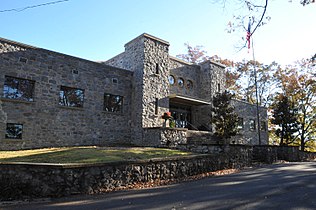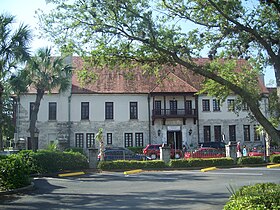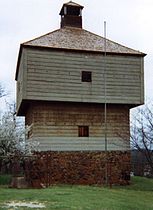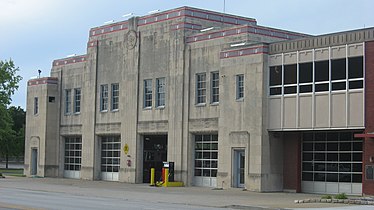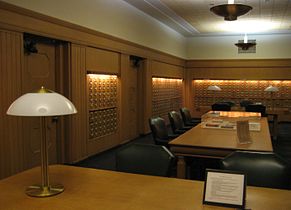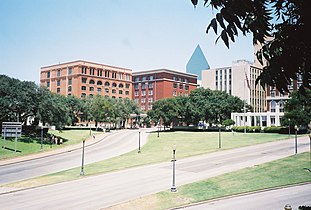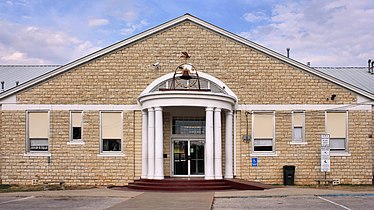מינהל קידום העבודות
מינהל קידום העבודות (באנגלית: Works Progress Administration, בראשי תיבות WPA; ומאז 1939 בשם מינהל מיזמי העבודה [באותם ראשי תיבות באנגלית]) היה רשות פדרלית אמריקאית שהוקמה במסגרת הניו דיל. המינהל העסיק מיליוני דורשי עבודה (בעיקר גברים ללא השכלה פורמלית) לביצוע עבודות ציבוריות כגון בניית מבני ציבור וסלילת כבישים.[1] הוא הוקם ב־6 במאי 1935, בצו נשיאותי, כחלק מרכזי בתוכנית הכלכלית שנקראה "הניו דיל השני".
פעילות המינהל[עריכת קוד מקור | עריכה]
ההקצאה הראשונה עבור המינהל, בשנת 1935, הייתה בסך 4.9 מיליארד דולר (כ־15 דולר לאדם בארצות הברית, וכ־6.7 אחוזים מהתמ"ג של 1935).[2] בראשו הוצב עובד ציבור בשם הארי הופקינס. המינהל סיפק למובטלים עבודה בשכר במהלך השפל הגדול בארצות הברית, תוך בניית תשתיות ציבוריות בארצות הברית, כגון פארקים, בתי ספר, וכבישים. רוב המשרות היו בתחום הבנייה והסלילה, ובמסגרתן נסללו יותר ממיליון קילומטרים של רחובות ויותר מעשרת אלפים גשרים, שדות תעופה רבים, והרבה יחידות דיור. מיזם הבנייה האחד הגדול ביותר שבנה המינהל הוא רשות עמק טנסי.
בשיא פעולתו, בשנת 1938, סיפק המינהל עבודה בשכר לשלושה מיליון גברים ונשים מובטלים, וכן לבני נוער בחטיבה נפרדת, בשם "מינהל הנוער הלאומי". בתקופה בין 1935 ל־1943, העסיק מינהל קידום העבודות סך של 8.5 מיליון בני אדם.[3] השכר לשעה שהציע המינהל היה בדרך כלל הרבה מתחת למקובל בתעשייה.[4] מטרת המינהל לא הייתה להגיע לתעסוקה מלאה של אוכלוסיית גיל העבודה (מטרה שהושגה בשנת 1942, והפכה יעד לאומי לטווח ארוך בשנת 1944), אלא לספק משרה אחת בשכר לכל המשפחות שבהן סבלו המפרנסים מאבטלה ממושכת.[5]: 64, 184
אחד המיזמים המפורסמים ביותר של המינהל היה מיזם בשם "מיזם פדרלי מספר 1". במסגרתו העסיק המינהל מוזיקאים, אמנים, סופרים, שחקנים, ובמאים במיזמי אמנויות, תיאטרון, תקשורת, ואוריינות.[1] חמשת התת־מיזמים שהוקדשו לאלה היו: מיזם הסופרים הפדרלי (FWP), סקר הרשומות ההיסטוריות (HRS), מיזם התיאטרון הפדרלי (FTP), מיזם המוזיקה הפדרלי (FMP) ומיזם האמנות הפדרלי (FAP). בסקר הרשומות ההסיסטוריות, למשל, ראיינו עובדי המינהל עבדים־לשעבר רבים בדרום ארצות הברית; למסמכים שהופקו חשיבות עצומה להיסטוריוגרפיה האמריקאית. להקות תיאטרון ומוזיקה ערכו מסעי הופעות ברחבי ארצות הברית וקיימו יותר מ־225,000 הופעות. מחקרים ארכאולוגיים שהתקיימו במסגרת המינהל תרמו משמעותית לגילוי מחדש של תרבויות ילידיות פרה-קולומביאניות, ולהתפתחות הארכאולוגיה המקצועית בארצות הברית.
מינהל קידום העבודות היה תוכנית פדרלית שהפעילה מיזמים משלה בשיתוף עם ממשלות מקומיות של מדינות הברית, אשר סיפקו מצידן בין 10 ל־30 אחוזים מהעלויות. בדרך כלל, הממשל העירוני או המדינתי סיפק קרקעות, ולעיתים קרובות גם משאיות ואספקה, ואילו מינהל קידום העבודות שילם את שכר העובדים (וכן את שכר המפקחים, שלא היו נתמכי סעד). במקרים מסוימים קיבל המינהל על עצמו את האחריות על תוכניות סיוע מדינתיות ומקומיות מוקדמות יותר, שמקורן בתאגיד מימון הבנייה מחדש (Reconstruction Finance Corporation, RFC) או בתוכניות של המינהל הפדרלי לסעד חירום (Federal Emergency Relief Administration, FERA).[5]: 63 ב־30 ביוני 1943 בוטל המינהל, עקב האבטלה הנמוכה במהלך מלחמת העולם השנייה. לפי סיכומו רוברט ד' ליינינג'ר: "מיליוני אנשים נזקקו להכנסה מינימלית. סעד בצורת תעסוקה נתפס כעדיף על דמי אבטלה, מכיוון ששמר על כבוד עצמי, חיזק את מוסר העבודה, ושמר על מיומנויות וכושר."[6]: 228
מבנה[עריכת קוד מקור | עריכה]
המינהל אורגן באגפים הבאים:
- האגף להנדסה ובינוי, אשר תכנן ופיקח על מיזמי בנייה לרבות שדות תעופה, סכרים, כבישים מהירים, ומערכות תברואה.[7]
- האגף למיזמים מקצועיים ושירותיים (שמו הפך ל"האגף למיזמי נשים ומיזמים מקצועיים" בשנת 1937), שהופקד על מיזמי צווארון לבן, בהם תוכניות חינוך, תוכניות פנאי ובידור, ומיזמי אמנויות. מאוחר יותר הפך שמו ל"האגף לתוכניות שירות קהילה", ואחר כך "אגף השירות".[8]
- אגף הכספים.[9]
- אגף המידע.[10]
- אגף החקירות, שהיה יורשו של אגף מקביל במינהל הפדרלי לסעד חירום (FERA), ועסק בחקירות הונאה, שימוש לרעה בכספים, ומעילה.[11]
- אגף הסטטיסטיקה, המכונה גם האגף למחקר חברתי.[12]
- אגף בקרת מיזמים, שבחן וטיפל בהצעות למיזמים.[13]
- אגפים נוספים, ובהם אגף התעסוקה, אגף ההנהלה, אגף הבטיחות, אגף האספקה, ואגף ההדרכה וההעסקה מחדש.[14]
מועסקים ידועים[עריכת קוד מקור | עריכה]
בין המובטלים שהועסקו על ידי המינהל נמנים גם:
מורשת[עריכת קוד מקור | עריכה]
הסוציולוג רוברט ד' ליינינג'ר סיכם: "למוסדות של ממשל פרנקלין ד' רוזוולט היה משקל עצום, שרובנו לא מכירים בו, בעיצוב המרחב הציבורי שבו אנו חיים כעת. בתקופה קצרה של עשר שנים, מינהל העבודות הציבוריות, מינהל קידום העבודות, וחיל השימור האזרחי בנו מתקנים כמעט בכל יישוב בארץ. רובם עדיין בשירות פעיל כעבור חצי מאה. הגיע הזמן שנכיר במורשת זו וננסה להבין את הקשר שלה למצבנו העכשווי."[6] : 226
-
בית עיריית סנטה אנה, קליפורניה (1935)
-
בית הממשל, סיינט אוגוסטין, פלורידה (1937)
-
בית הקאנו, אוניברסיטת איווה (1937)
-
בית המשפט המחוזי, לינטון, מחוז אמונס, דקוטה הצפונית (1934)
-
אצטדיון מקוי, פוטאקט, רוד איילנד (1942)
-
תיאטרון דוק סטריט, צ'ארלסטון, קרוליינה הדרומית (1937)
-
פארק הדינוזאורים, רפיד סיטי, דקוטה הדרומית (1936)
-
בית ספר, לומטה, טקסס (1938–1940)
-
טיילת הנהר, סן אנטוניו, טקסס (1939)
-
בית המשפט של מחוז ראלי, בקלי, וירג'יניה המערבית (1936–37)
לקריאה נוספת[עריכת קוד מקור | עריכה]
- Adams, Don; Goldbard, Arlene. "New Deal Cultural Programs: Experiments in Cultural Democracy." Webster's World of Cultural Democracy 1995.
- Halfmann, Drew, and Edwin Amenta. "Who voted with Hopkins? Institutional politics and the WPA." Journal of Policy History 13#2 (2001): 251–287. online
- Hopkins, June. "The Road Not Taken: Harry Hopkins and New Deal Work Relief" Presidential Studies Quarterly 29#2 (1999): 306–16 online
- Howard, Donald S. WPA and federal relief policy (1943), 880pp; highly detailed report by the independent Russell Sage Foundation.
- Kelly, Andrew, Kentucky by Design: The Decorative Arts, American Culture and the Arts Programs of the WPA. Lexington: University Press of Kentucky. 2015.
- Larson, Cedric. "The Cultural Projects of the WPA." The Public Opinion Quarterly 3#3 (1939): 491–196. Accessed in JSTOR
- Leighninger, Robert D. "Cultural Infrastructure: The Legacy of New Deal Public Space." Journal of Architectural Education 49, no. 4 (1996): 226–236.
- Leighninger, Robert D., Jr. Long-Range Public Investment: the Forgotten Legacy of the New Deal. Columbia, S.C.: University of South Carolina Press (2007).
- Lindley, Betty Grimes & Lindley, Ernest K. A New Deal for Youth: the Story of the National Youth Administration (1938)
- McJimsey George T. Harry Hopkins: Ally of the Poor and Defender of Democracy (1987) online
- Mathews, Jane DeHart. Federal Theatre, 1935-1939: Plays, Relief, and Politics (Princeton UP 1967) online
- Meriam; Lewis. Relief and Social Security. 900 pp. Washington, DC: The Brookings Institution, 1946.
- Millett; John D. & Gladys Ogden. Administration of Federal Work Relief 1941.
- Musher, Sharon Ann. Democratic Art: The New Deal's Influence on American Culture. Chicago: University of Chicago Press, 2015.
- Rose, Nancy. The WPA and Public Employment in the Great Depression (2009)
- Sargent, James E. "Woodrum's Economy Bloc: The Attack on Roosevelt's WPA, 1937–1939." Virginia Magazine of History and Biography (1985): 175–207. in JSTOR
- Sheppard, Si. Buying of the Presidency?, The: Franklin D. Roosevelt, the New Deal, and the Election of 1936 (ABC-CLIO, 2014).
- Singleton, Jeff. The American Dole: Unemployment Relief and the Welfare State in the Great Depression (2000)
- Smith, Jason Scott. Building New Deal Liberalism: the Political Economy of Public Works, 1933–1956 (2005)
- Taylor, David A. Soul of a People: The WPA Writers' Project Uncovers Depression America. (2009)
- Taylor, Nick. American-Made: The Enduring Legacy of the WPA: When FDR Put the Nation to Work (2008)
- United States Senate. "Report of investigation of public relief in the District of Columbia". Washington D.C.: 1938
- Williams, Edward Ainsworth. Federal aid for relief (1939)
- Young, William H., & Nancy K. The Great Depression in America: a Cultural Encyclopedia. 2 vols. Westport, Conn.: Greenwood Press, 2007 ISBN 0-313-33520-6
קישורים חיצוניים[עריכת קוד מקור | עריכה]
- היסטוריה בעל פה שתועדה במסגרת המינהל לקידום העבודות, באוניברסיטת ג'ורג' מייסון (אנגלית)
- אתר מיזם "הניו דיל חי וקיים" ובו תיעוד רב של מפעלות מינהל קידום העבודות (אנגלית)
- אוסף מינהל קידום העבודות בספרייה הציבורית של ניו יורק. (אנגלית)
- אוסף ציורים וציורי קיר שנוצרו בידי אמנים שכירים של מינהל קידום העבודות (אנגלית)
- מינהל קידום העבודות, באתר אנציקלופדיה בריטניקה (באנגלית)
- כתבי מינהל קידום העבודות בפרויקט גוטנברג (באנגלית)
הערות שוליים[עריכת קוד מקור | עריכה]
- ^ 1 2 Arnesen, Eric (2007). Encyclopedia of U.S. Labor and Working-Class History. Vol. 1. New York: Routledge. p. 1540. ISBN 9780415968263.
- ^ Smith, Jason Scott (2006). Building New Deal Liberalism: The Political Economy of Public Works, 1933–1956. New York: Cambridge University Press. p. 87. ISBN 9780521828055.
- ^ "WPA Pays Up and Quits". The New York Times. 1 ביולי 1943. נבדק ב-2016-02-24.
{{cite news}}: (עזרה) - ^ Neumann, Todd C. (2010). "The Dynamics of Relief Spending and the Private Urban Labor Market During the New Deal" (PDF). The Journal of Economic History. 70 (1): 195–220. doi:10.1017/S0022050710000100.
- ^ 1 2 Leighninger, Robert D. (2007). Long-Range Public Investment: The Forgotten Legacy of the New Deal. Columbia, S.C.: University of South Carolina Press. ISBN 9781570036637.
- ^ 1 2 Leighninger, Robert D. (במאי 1996). "Cultural Infrastructure: The Legacy of New Deal Public Space". Journal of Architectural Education. 49 (4): 226–236. doi:10.1080/10464883.1996.10734689. JSTOR 1425295.
{{cite journal}}: (עזרה) - ^ "Records of the Division of Engineering and Construction". Records of the Work Projects Administration (WPA). National Archives and Records Administration. נבדק ב-2016-02-27.
- ^ "Records of the Division of Professional and Service Projects". Records of the Work Projects Administration (WPA). National Archives and Records Administration. נבדק ב-2016-02-27.
- ^ "Records of the Division of Finance". Records of the Work Projects Administration (WPA). National Archives and Records Administration. נבדק ב-2016-02-27.
- ^ "Records of the Division of Information". Records of the Work Projects Administration (WPA). National Archives and Records Administration. נבדק ב-2016-02-27.
- ^ "Records of the Division of Investigation". Records of the Work Projects Administration (WPA). National Archives and Records Administration. נבדק ב-2016-02-27.
- ^ "Records of the Division of Statistics". Records of the Work Projects Administration (WPA). National Archives and Records Administration. נבדק ב-2016-02-27.
- ^ "Records of the Project Control Divisions". Records of the Work Projects Administration (WPA). National Archives and Records Administration. נבדק ב-2016-02-27.
- ^ "Records of Other WPA Divisions". Records of the Work Projects Administration (WPA). National Archives and Records Administration. נבדק ב-2016-02-27.

